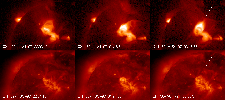Cusp and CME
Science Nugget: Mar 26, 1999
1.Motivation
This week's topic largely overlaps with last
week's nugget, but it is from a different perspective. Also, given
the frequency of cusp structures seen in SXT images and their relations
with an important process, the topic should never be stale. A cusp structure
is easily distinguished from other roundish loops. For a typical cusp,
click here. Indeed, Yohkoh's real-time
operators (mostly scientists) often mention a cusp in the report sent after
each contact.
A cusp structure could arise from closed magnetic field lines stretched
by solar wind. But it is often assumed to represent the presence of open
field lines surrounding the closed ones. If these field lines are oppositely
directed, they will be converted to closed loops through magnetic reconnection,
process widely considered to be the primary energy release mechanism
for eruptive solar flares and coronal mass ejections (CMEs). Indeed, the
cusp structure is now used as proxy to an eruption and hence a CME (see
Canfield,
Hudson and McKenzie in GRL).
However, this week's author has several naive questions.
How does a cusp form? We see it most pronouncingly after the impulsive
phase, by which time the most energetic part of a flare is already over.
If the cusp is a configuration that leads to magnetic reconnection (which
is responsible for flare energy release), why don't we see it before the
impulsive phase?
How does a cusp really compare with a CME? Does its appearance give
any hint of the nature of the associated CME? Aren't there other features
in X-ray/EUV images that are better correlated with CMEs?
2. Quick Analysis and Result
We studied the SXT movie recorded on laserdisc, focusing on the period
after 1996 because of the SoHO coverage. Identifying certain features (such
as `cusps', `anemones', `sigmoids' - solar physics is full of such beautiful
jargons) in image data is always subjective unless their definitions are
spelled out quantitatively. So only very clear cusps were picked up (a
total of 22). Then the
event list of SoHO/LASCO was searched to see if there was indeed a
CME around the time a cusp was seen by SXT. This event list is well-maintained,
providing the location of the CME and clearly differentiating between ``no
CME'' and ``no data''.
We found a CME in 15 of the 22 cusps. No CME was found in 5 cusps. For
the remaining 2 cusps, there was no LASCO coverage. This result itself
may not be too surprising since no one-to-one correspondence has been established
between CMEs and long duration events (LDEs), which are probably well correlated
with cusps. The LASCO event list shows lots of CMEs at times when there
are no clear cusps in SXT images. Moreover, we well know (as reported several
times in this series of science nugget) that eruptive features are often
seen in SXT images, no matter whether cusps exist. These may be more direct
indicators for CMEs.
3. Orientation of Cusp
If we adhere to a cusp as an important indicator for a CME, it would be
interesting to study where the CME is located with respect to the orientation
of the cusp. It is expected that material is ejected largely in the direction
of increasing height although with wide angles. The figure below (click
to enlarge) shows SXT (upper row) and SoHO/EIT (lower row) images of a
flare that occurred near disk center, slightly to north. The arrow of the
right-hand images show a clear cusp in the SXT image, which is missing
in the EIT image, indicating that the cusp is hot. In any case, the cusp
is pointing to northwest. The disturbance in the EIT images is seen to
propagate also in northwest.

However, the most pronounced enhancement in the associated (halo) CME
is in the northeast quadrant. A LASCO C2 image is shown below.

This difference between the orientation of the cusp and the location
of the CME is commonly seen, in our samples, implying that the CME can
be at a location very different from what we expect from the position and
the orientation of the cusp. This suggests that a CME occurs on a much
larger scale than a bright loop or cusp structure seen in SXT images. In
the above event, it is possible that material ejected initially to northwest
may have been deflected to east by large-scale magnetic field. It should
also be reported that SXT images reveal motions of diffuse emission toward
northeast. This indicates that some form of X-ray ejecta may be part of
the CME.
We should continue comparing SXT/EIT/LASCO images in more cases
to be certain about what SXT images tell us about CMEs.
28 March 1999: Nariaki Nitta (email nitta@lmsal.com)


